Sieve tubes are suited for translocation of food because they possess
bordered pits.
no ends walls.
broader lumen and perforated cross walls.
no protoplasm.
Correct Answer :
C. broader lumen and perforated cross walls.
Phloem is a conducting tissue that transports food materials, usually from leaves to other part of the plants. In phloem, sieve elements arranged one above the other in distinct linear rows and have sieve plates (oblique or transverse perforated septa) on their end walls. These are associated with companion cells.
Related Questions
When we peel the skin of a potato tuber, we remove
periderm
epidermis
cuticle
leaves
A common structural feature of vessel elements and sieve tube elements are
pores on lateral walls.
presence of p-protein.
enucleate condition.
thick secondary walls.
Which of the following statement(s) is/are correct ?
- Uneven thickening of cell wall is characteristic of sclerenchyma.
- Periblem forms cortex of the stem and the root.
- Tracheids are the chief water transporting elements in gymnosperms.
- Companion cell is devoid of nucleus at maturity.
- The commercial cork is obtained from Quercus suber.
(i) and (iv) only
(ii) and (v) only
(iii) and (iv) only
(ii), (iii) and (v) only
Cells of permanent tissues are specialized
functionally.
only structurally.
both structurally and functionally.
for mitosis.
The given figure shows the secondary growth in a dicot stem. Their parts are marked as A, B, C, D, E & F. Choose the correct labelling of the parts marked as A to F.

A Phellem, B Phellogen, C Medullary rays, D Secondary xylem, E Secondary phloem, F Cambium ring
A Phellem, B Phellogen, C Medullary rays, D Secondary phloem, E Secondary xylem, F Cambium ring
A Phellogen, B Phellem, C Medullary rays, D Secondary xylem, E Secondary phloem, F Cambium ring
A Phellem, B Phellogen, C Cambium ring, D Secondary xylem, E Secondary phloem, F Medullary rays
Which of the following statement(s) is/are not correct?
- Cork cambium is also called phellogen.
- Cork is also called phellem.
- Secondary cortex is also called periderm.
- Cork cambium, cork and secondary cortex are collectively called phelloderm.
(iii) and (iv)
(i) and (ii)
(ii) and (iii)
(ii) and (iv)
Which of the following is responsible for the formation of an embryonic shoot called axillary bud?
Lateral meristem
Apical meristem
Intercalary meristem
Both
Sieve tubes are suited for translocation of food because they possess
bordered pits.
no ends walls.
broader lumen and perforated cross walls.
no protoplasm.
Which of the following pair of match is not correct?
Pith - Large and well developed in monocotyledonous root.
Root hairs - Helps in preventing water loss due to transpiration
Sieve tube elements - Its functions are controlled by the nucleus of companion cells.
Stomatal apparatus - Consists of stomatal aperture, guard cells and surrounding subsidiary cells
Identify the types of simple tissue indicated by A, B, C and D and their function.
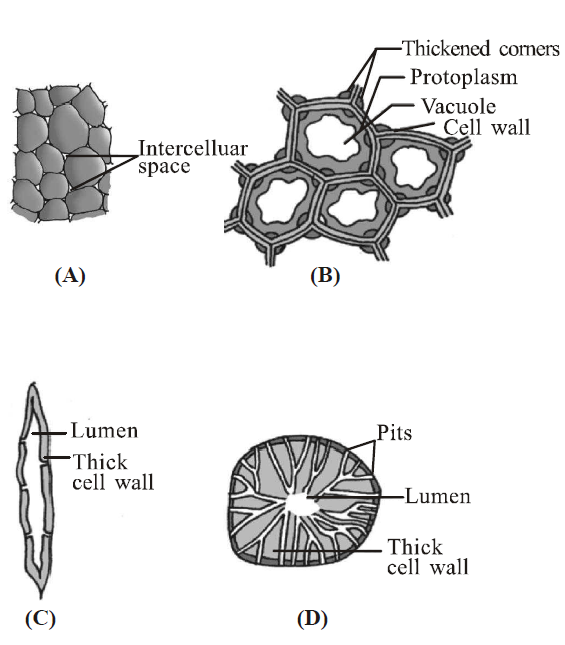
A Parenchyma, Photosynthesis, Storage and Secretion.
B Sclerenchyma Scleriods; Transport food material
C Collenchyma; Provides mechanical support to organs.
D Sclerenchyma Fibres; Provide Mechanical support to the growing parts of the plant such as young stem and petiole of a leaf.
The given figure shows T.S. of monocot stem. Identify the correct labelling of A to F marked in the given figure.
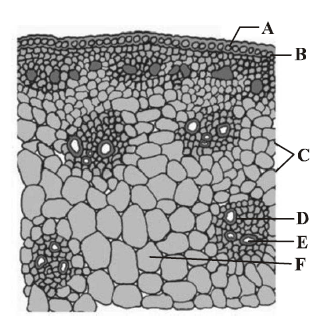
A Epidermis, B Hypodermis, C Vascular bundles, D Phloem, E Xylem, F Ground tissue
A Cuticle, B Epidermis, C Sclerenchymatous sheath, D Sclerenchymatous hypodermis, E Parenchymatous sheath, F Phloem
A Cuticle, B Epidermis, C Sclerenchymatous hypodermis, D Sclerenchymatous sheath, E Parenchymatous sheath, F Phloem
A Cuticle, B Epidermis, C Sclerenchymatous hypodermis, D Sclerenchymatous sheath, E Parenchymatous sheath, F Protoxylem
Which of the following statements are correct ?
- Xylem transports water and minerals.
- Gymnosperms lack sieve tubes and companion cells in phloem.
- The first formed primary xylem is called metaxylem.
- Phloem fibres (bast fibres) are made up of collenchymatous cells.
(i) and (iii)
(i) and (ii)
(iii) and (iv)
(i) and (iv)
The given figures are types of elements (A and B) which constitute one type of complex tissue (c) of a plant . Identify A, B and C.
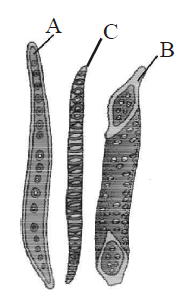
A Tracheid, B Vessel, C Xylem
A Vessel, B Tracheild, C Phloem
A Fibre, B Tracheid, C Bark
A Fibre, B Sclereid, C Casparian strips
A piece of wood having no vessels (trachea) must be belonged to
teak
mango
pine
palm
The vessel elements of angiosperms differ from other elements of xylem in having
simple pits on their radial walls.
bordered pits on their lateral walls.
simple and bordered pits on their end walls.
simple perforation on their end walls.
Which of following helps bamboo and grasses to elongate ?
Apical meristems
Lateral meristems
Secondary meristems
Intercalary meristems
A narrow layer of thin walled cells found between phloem/ bark and wood of a dicot is
cork cambium
vascular cambium
endodermis
both (a) & (c)
One of the primary function of the ground tissue in a plant is
photosynthesis.
to protect the plant.
to anchor the plant.
water and sugar conduction.
Lignin is the important constituent in the cell wall of
phloem
parenchyma
xylem
cambium
Bast fibres are made up of _____________cells.
sclerenchymatous
chlorenchymatous
parenchymatous
aerenchymatous
Choose the correct labelling of (A J) in the given figure of T.S. of monocot root.

A Root hair, B Epiblema, C Cortex, D Endodermis, E Passage cell, F Pericycle, G Pith, H Phloem, I Metaxylem.
A Root hair, B Epiblema, C Cortex, D Endodermis, E Passage cell, F Pith, G Pericycle, H Metaxylem, I Phloem.
A Root hair, B Epiblema, C Cortex, D Endodermis, E Pericycle, F Phloem, G Protoxylem, I Metaxylem
A Root hair, B Cortex, C Epiblema, D Pericycle, E Endodermis, F Pith, G Phloem, H Protoxylem, I Metaxylem
A plant tissue when stained showed the presence of hemicellulose and pectin in cells wall of its cells. The tissue is called
collenchyma
sclerenchyma
xylem
meristem
Tissue(s) present in an annual ring is/are
secondary xylem and phloem.
primary xylem and phloem.
secondary xylem only.
primary phloem and secondary xylem.
Which of the following figure is a type of permanent tissue having many different types of cell?
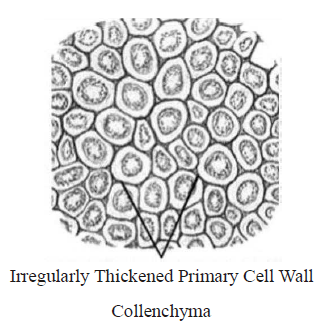
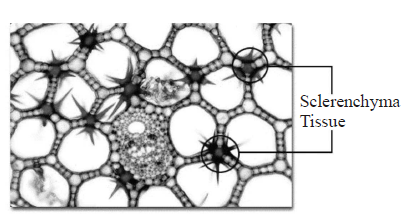
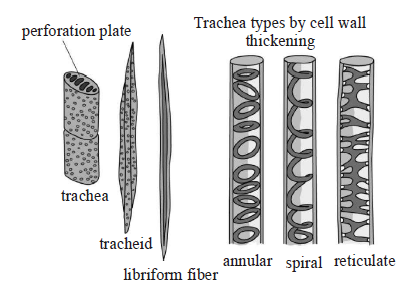
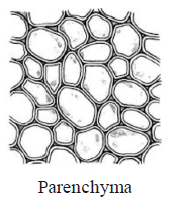
The __________ occurs in layers below the epidermis in dicotyledonous plants.
parenchyma
sclerenchyma
collenchyma
aerenchyma
An organised and differentiated cellular structure having cytoplasm but no nucleus is called _________.
vessels
xylem parenchyma
sieve tubes
tracheids
Match column-I with column-II and choose the correct option.
| Column -I | Column -II |
|---|---|
| A. Bulliform cells | I. Initiation of lateral roots |
| B. Pericycle | II. Root |
| C. Endarch xylem | III. Grasses |
| D. Exarch xylem | IV. Dicot leaf |
| E. Bundle sheath cells | V. Stem |
A III, B V, C IV, D I, E II
A II, B V, C I, D III, E IV
A II, B IV, C I, D III, E V
A III, B I, C V, D II, E IV
The given diagrams show stomatal apparatus in dicots and monocots. Which one is correct option for A, B and C?

A Epidermal cells; B Subsidiary cells; C chloroplast
A Guard cells; B Subsidiary cells; C Stomatal pore
A Guard cells; B Epidermal cells; C Guard cells
A Epidermal cells; B Subsidiary cells; C Guard cells
Which meristem helps in increasing girth?
Lateral meristem
Intercalary meristem
Primary meristem
Apical meristem
Match the elements of xylem given in column I with their character given in the column II and choose the correct option.
| Column-I | Column-II |
|---|---|
| A. Xylem vessels | I. Store food materials |
| B. Xylem tracheids | II. Obliterated lumen |
| C. Xylem fibres | III. Perforated plates |
| D. Xylem parenchyma | IV. Chisel-like ends |
A IV; B III; C II; D I
A III; B II; C I; D IV
A II; B I; C IV; D III
A III; B IV; C II; D I
